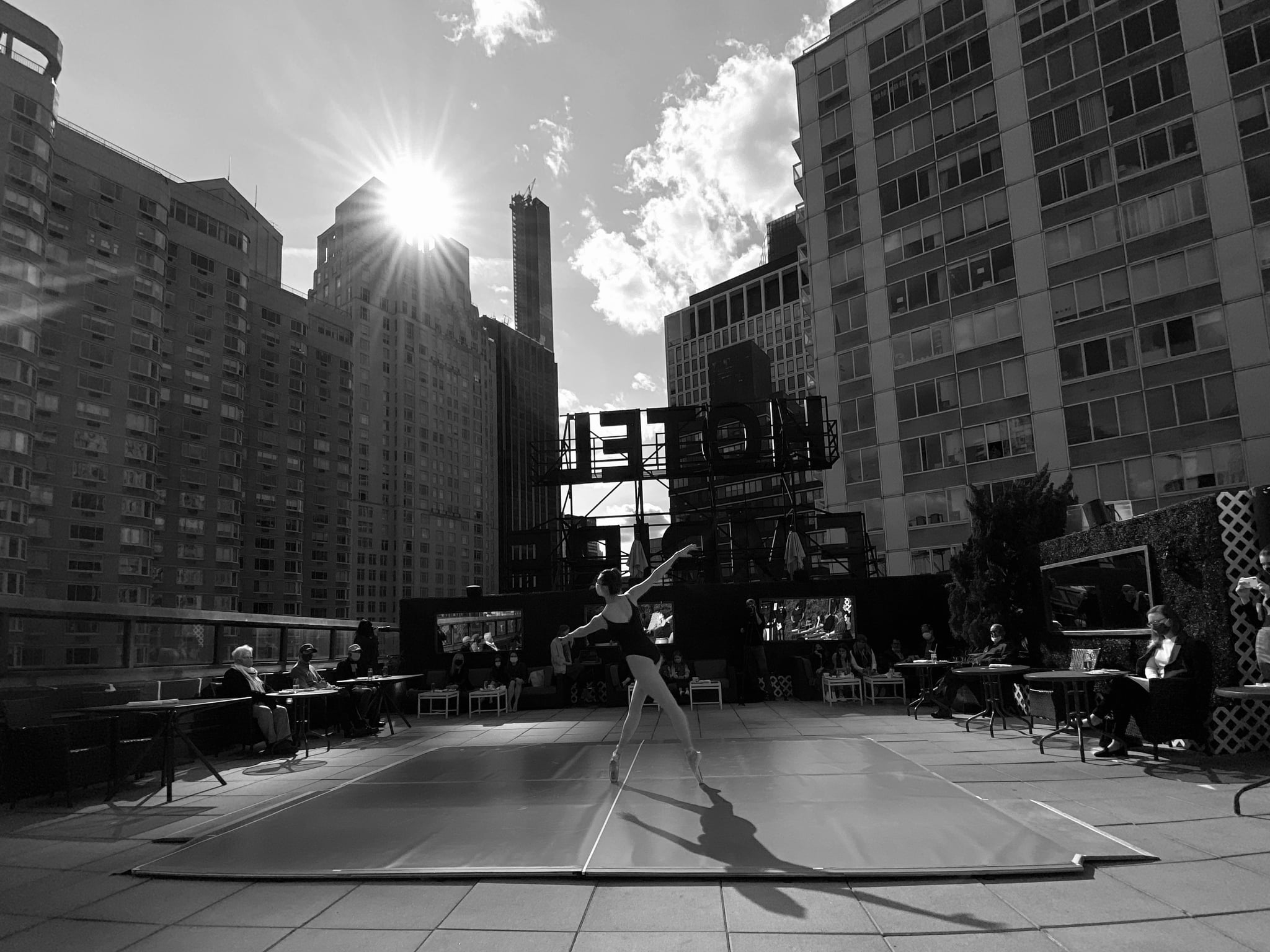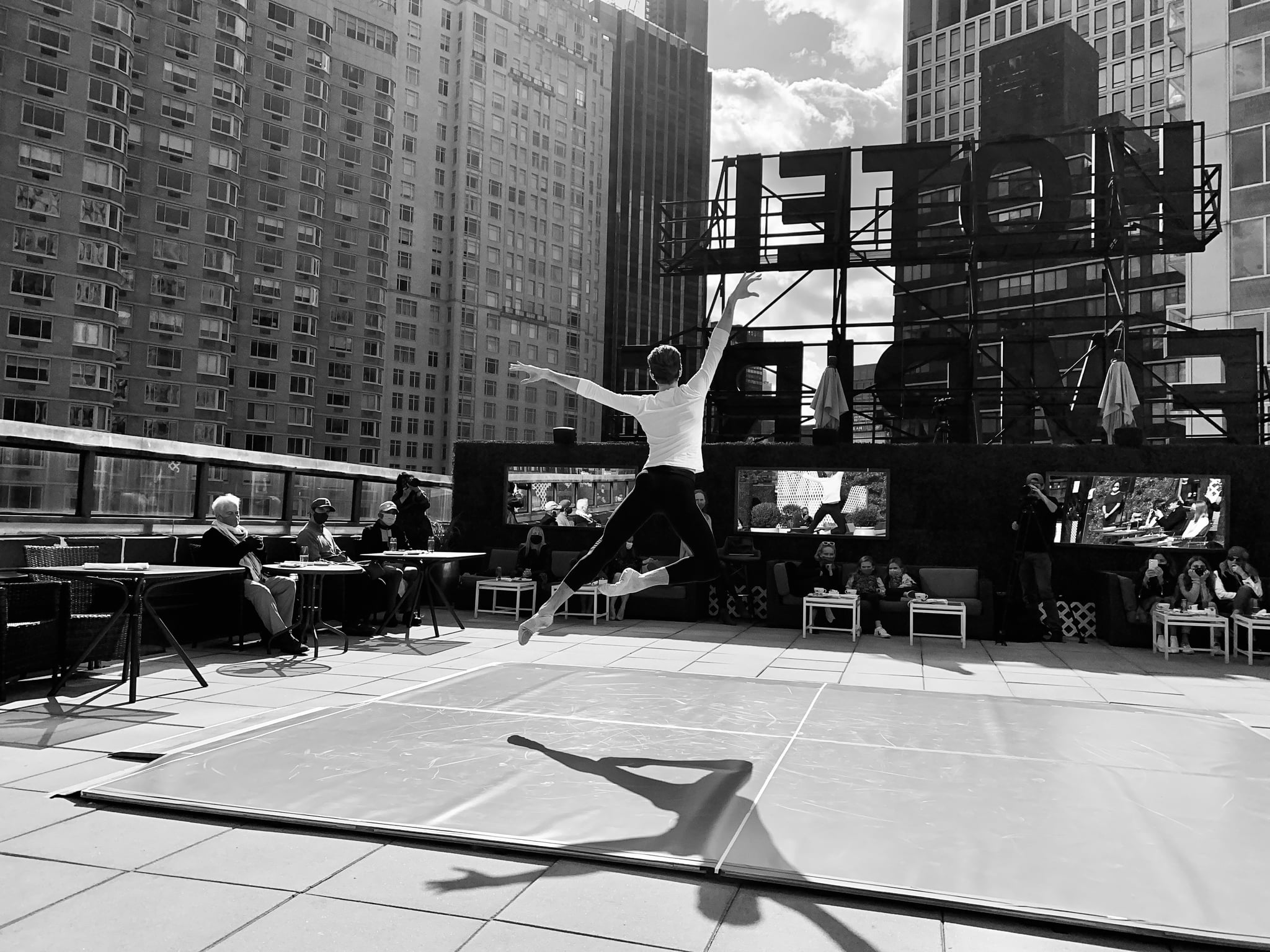
Though there are glimmers of hope that the US could finally be emerging from the COVID-19 pandemic, there’s no denying the toll that the virus has taken this past year. Nearly 32 million Americans have been infected with COVID-19, and more than 565,000 have died. Our collective grief has only been magnified by a full-fledged economic crisis. Millions of workers were laid off or furloughed because of COVID-19 restrictions, with one of the most ravaged industries being the performing arts. Musicians, actors, and dancers were all sidelined as the nation went into lockdown — and with live performances still posing a risk, many remain out of work.
But as POPSUGAR learned while speaking with four ballet dancers — who together helped create Dancers of NYCB, a fund to support the dancers and stage managers of the New York City Ballet and beyond — these performers still found purpose and an audience, despite losing their stage.
In early 2020, Daniel Applebaum was finally getting his footing, after being promoted to soloist the year before. Jovani Furlan, a Brazilian transplant, was excited to find his place and contribute to the art scene in New York. India Bradley was focused on improving her port de bras and turnout. Lauren King was ready to explore the next phase of her career in the arts after dancing for 17 years. As she put it, “no one in the industry was prepared for this.”
“Art is the most essential thing there is.”
When theaters and other venues first closed their doors, Furlan missed the thrill — and utter exhaustion — of training and performing the most. “It fills my heart and soul,” he told POPSUGAR. Then came the financial worries, the disappointment about roles he would no longer be able to dance, and the more general concern about the future of the performing arts. “With that came a bit of anger,” Furlan explained. For him, the COVID-19 pandemic shed even more light on the fact that the arts don’t seem to be a priority, “even though in moments like this — or any difficult moment, really — everyone turns to music, a good book, movies, and TV shows to find comfort and distraction. Art is the most essential thing there is.”
Though their goals and plans — like many of ours — were put on hold by the pandemic, these dancers united around a common cause: helping to provide much-needed relief to dancers and stagehands, who were facing unprecedented challenges. “As dancers, we rarely advocate for ourselves,” King told POPSUGAR. But when they realized that it would be a long time before ballet could be performed for an audience again, they knew they needed to step up to support one another.
Finding Community in a Time of Crisis
Being a dancer may seem glamorous, but from a financial perspective, that often isn’t the reality. “Even the most prolific dancers typically retire in their 30s or early 40s, and must find new ways to make money once their dancing career is over,” King explained. A year like this one — during which so many artists made little to no money — “is particularly difficult for young dancers who do not have money saved, and for the international dancers who are unable to collect unemployment benefits or gain other employment because of their visa status in the US.”
Enter: the fund. “The DoNYCB fund was a brilliant concept thought up by the dancers and stage managers that work for NYCB,” Bradley told POPSUGAR, adding that the group came together in crisis the same way they do on stage: “like a well-oiled machine.” King explained that union delegates were able to negotiate a way to use the American Guild of Musical Artists (AGMA) Relief Fund to collect donations for performers and other workers who were union members.
Once the necessary pieces were in place, the organization’s four steering committee members — King, Meaghan Dutton-O’Hara, Ralph Ippolito, and Teresa Reichlen — began making plans for fundraising. “Everyone who came on was so thoughtful about prioritizing a collaborative effort of dancers, divested from our familiar hierarchy, and it was exciting to help shape a new way of supporting dancers and reconnecting to our art form,” Applebaum told POPSUGAR.

“When you’re away from something for so long, you can begin to question its value. Live dance is important. Live theater is important.”
To date, they’ve organized a variety of fundraisers, from an Iron Chef-inspired cooking challenge featuring several dancers, to a silent auction, to digital dance workshops, to a socially-distanced performance on the rooftop of the Empire Hotel. The latter, which took place in the fall, was undoubtedly the most cathartic. “When I watched my friends take the stage at the Empire Hotel rooftop, I cried. A lot,” said Applebaum, who produced the performance alongside King. “When you’re away from something for so long, you can begin to question its value. Live dance is important. Live theater is important.”
In November, when the organization met its first fundraising goal — which made it possible to send paychecks to all the dancers and stagehands — “we were absolutely thrilled,” Bradley said.
It was an important benchmark in providing stability to those who were out of work, but it also signaled that the dancers had made “a clear connection” with their city and the dance community at large, King explained, noting that during an unprecedented time, the initiative has given dancers a way to share their voices beyond the stage, take on projects they’re passionate about, and “hopefully become more relatable to those who find dance — and ballet, in particular — unapproachable.”
Looking Ahead to Life After COVID
These artists have still faced challenges, ones they’ll be happy to put behind them when the pandemic comes to an end. “I’ve always been resilient, but I did lose perspective at many points during this pandemic,” said Furlan, who’s been living in Brazil — thousands of miles away from his boyfriend and fellow dancers in New York — after hitting roadblocks in international residency and travel. “Somehow, something or someone always came my way to put me back on the right track. Dancers are responsible and self-motivated, so I’ve been relying on the way I’ve been trained and the way I’ve led my professional life, competing with myself and doing what I can today — just today — and then tomorrow you see what you can do again.”
While there’s a level of toughness and resilience that’s innate in trained dancers, “the pandemic has taught all of us the need for community,” Applebaum said. “It’s also shown us the need for nimbleness in arts organizations and, hopefully, DoNYCB can be a vital part of that conversation — by sharing our learned experience, but also inviting and welcoming perspectives different from our own. Our privilege offers us the ability to shape dance in our small NYCB bubble, but hopefully, we can expand those conversations beyond ourselves.”
The pandemic reminded each of these dancers — and arguably, the world — that the arts are so much more than entertainment. They’re a vital part of the human experience, something that binds us together and helps us feel alive, particularly during times of chaos and isolation. “It has been nice to find ways to continue to share the arts with people beyond the stage,” King said, echoing a desire shared by the other dancers: that this initiative continue on in some form even after they’re back on the stage at Lincoln Center. “All of the Dancers of NYCB are some of the most talented, passionate, and inspiring people I know,” King said. “I am hopeful for the future of what dancers can share with the world, both as dancers and as humans.”
If you would like to contribute to Dancers of NYCB, visit dancersofnycb.com
Image Source: Devin Alberda / Dancers of NYCB
